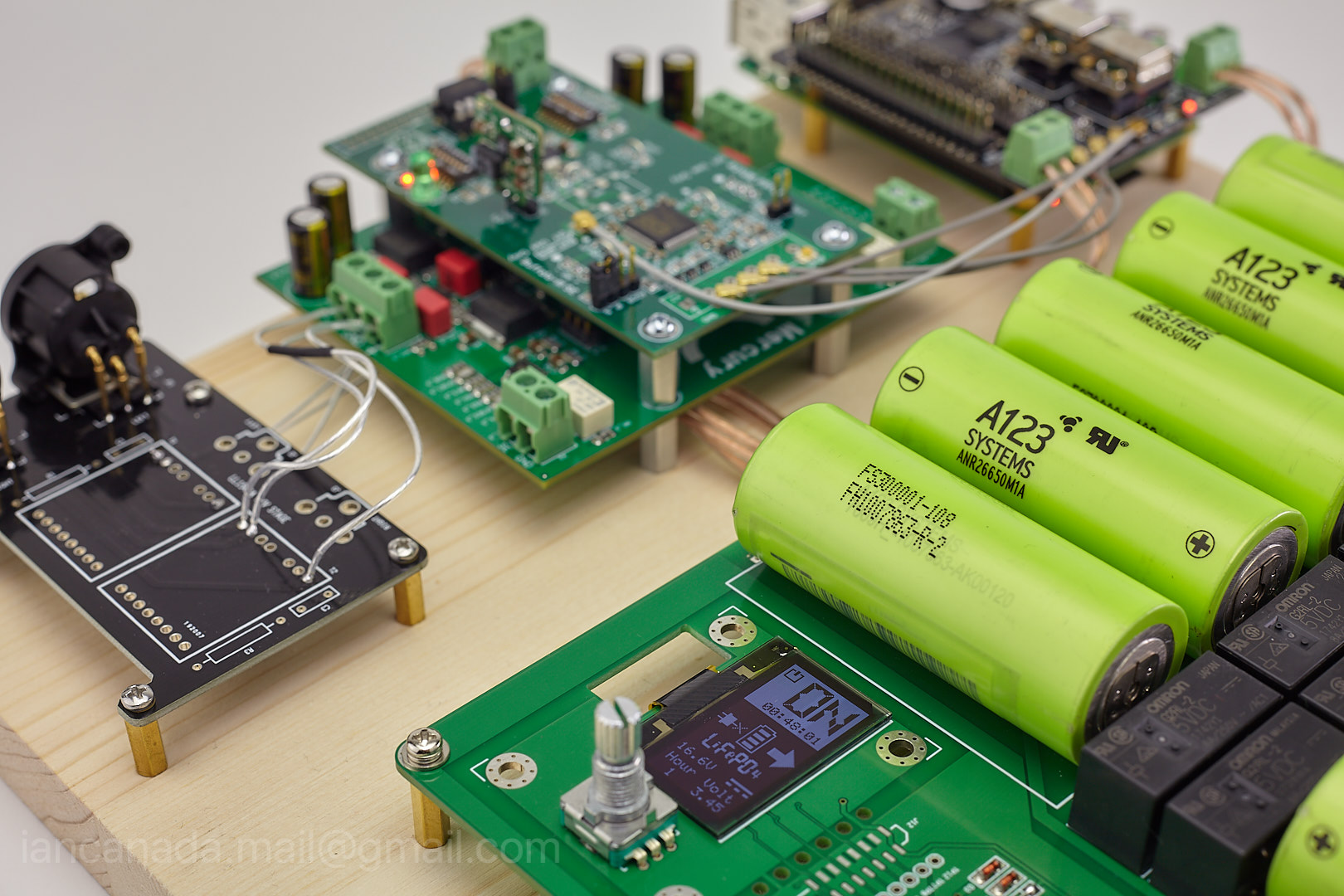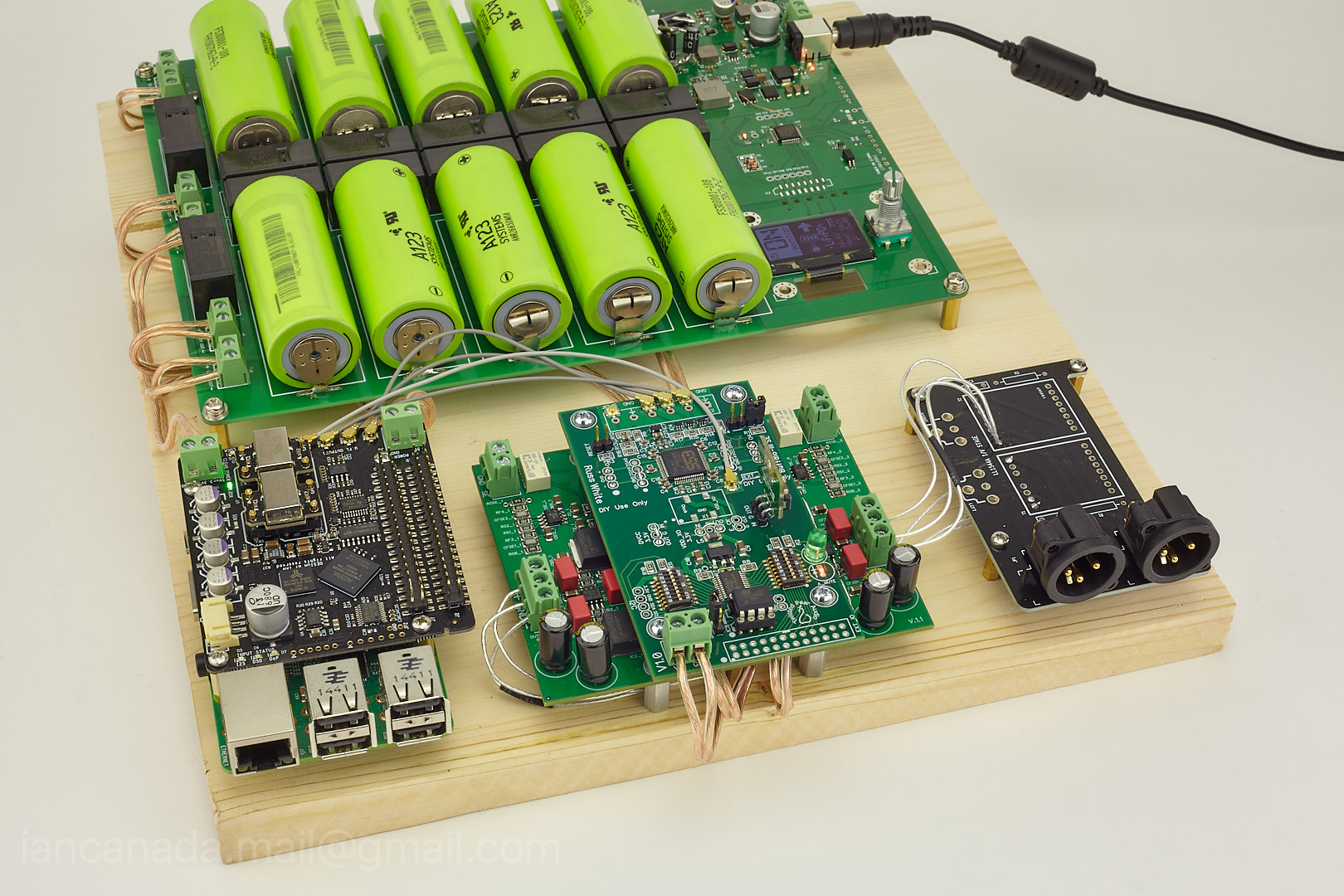LifePO4 power supply starts working
Firmware is partly finished. LifePO4 power supply is working now. Really excited about it.
I'm busy at integrating and testing with real DAC project. More update will be posted very soon.

LifePO4PowerSupplyWorks_1 by Ian, on Flickr
Good weekend.
Ian
Firmware is partly finished. LifePO4 power supply is working now. Really excited about it.
I'm busy at integrating and testing with real DAC project. More update will be posted very soon.

LifePO4PowerSupplyWorks_1 by Ian, on Flickr
Good weekend.
Ian
Last edited:
Firmware is partly finished. LifePO4 power supply is working now. Really excited about it.
I'm busy at integrating and testing with real DAC project. More update will be posted very soon.
LifePO4PowerSupplyWorks_1 by Ian, on Flickr
Good weekend.
Ian
Like the tiny display, looking really good.
Good work Ian.Fantastic!!Firmware is partly finished. LifePO4 power supply is working now. Really excited about it.
I'm busy at integrating and testing with real DAC project. More update will be posted very soon.
Good weekend.
Ian
no anticipation on how the ultracaps will be managed? Is it possible that they will be powered by this LiFePO4 card?
Like the tiny display, looking really good.
@marcus1
Yes, it's useful for settings, management and monitoring. It's a 1.3" OLED screen, not the smallest one. In V2.0 hardware design, this OLED screen together with the control knob can be break from the main PCB as a control panel.
@sontero
Thanks!
Ian
Is it possible that they will be powered by this LiFePO4 card?
Why on earth would you want that? Purer electrons?
like this:Why on earth would you want that? Purer electrons?
ES9018K2M, ES9028Q2M, 9038Q2M DSD/I2S DAC HATs for Raspberry Pi
Hello Ian,
how do you achieve 3.3V without using LDO? Not easy to understand with your block diagram.
Don‘t forget output protection, safety first!
Are the LifePO4 protected?
JP
how do you achieve 3.3V without using LDO? Not easy to understand with your block diagram.
Don‘t forget output protection, safety first!
Are the LifePO4 protected?
JP
I had already asked this question. lookHello Ian,
how do you achieve 3.3V without using LDO? Not easy to understand with your block diagram.
Don‘t forget output protection, safety first!
Are the LifePO4 protected?
JP
@sontero
Thanks you, but Ian‘s answer isn‘t complete.
1S LifePO4 goes down from 3.6V to 2V so I‘m thinking powered DAC is off by reaching 3V (3.3V +/- 10%) and you‘ve to go in charging mode?
JP
Thanks you, but Ian‘s answer isn‘t complete.
1S LifePO4 goes down from 3.6V to 2V so I‘m thinking powered DAC is off by reaching 3V (3.3V +/- 10%) and you‘ve to go in charging mode?
JP
Still don't get it. For a quick trial it is a a great and easy idea, but i have little doubt Ian's charging circuit for the ultracaps will be safe without involving batteries.
me also ......I would expect that between batteries and ultracaps there was a charger ..... like a cc / cv adjustable step down charger (where you could set the voltage and amperage)Still don't get it. For a quick trial it is a a great and easy idea, but i have little doubt Ian's charging circuit for the ultracaps will be safe without involving batteries.
Hello Ian,
how do you achieve 3.3V without using LDO? Not easy to understand with your block diagram.
Don‘t forget output protection, safety first!
Are the LifePO4 protected?
JP
@ JP
That's a good question.
All isolated voltage rails are LifePO4 battery direct. That's the whole design idea: to take the advantage of the super good performance (more closed to ideal power supply) of battery. The LifePO4 battery cell has quite stable discharge(100%-20%) voltage around 3.3V. That's why only LifePO4 batteries suitable for this kind of application.
And LDO after battery will degrade the power supply performance. If you want to use LDO, then you don't have to use battery.
This design has full set of battery protection features, over-charge, over-discharge, over-charge current and many others. The max charge voltage is limited and settable. The max charge current is limited too. The max operating time is also programmable. I could but I would not add the dis-charge current limitation because it will increase the output resistance thus possible to degrade the sound quality. Even with all those kinds of protections, I still think the LiefPO4 power supply will be more suitable for skilled DIYers rather than beginners.
Good weekend.
Ian
@sontero
Thanks you, but Ian‘s answer isn‘t complete.
1S LifePO4 goes down from 3.6V to 2V so I‘m thinking powered DAC is off by reaching 3V (3.3V +/- 10%) and you‘ve to go in charging mode?
JP
@ JP
Your concern is very reasonable.
This LifePO4 power supply is equiped with isolated voltage monitoring features. When dis-charge voltage is lower than the threshold voltage (say 3.15V, around -4.5% of 3.3V), the power supply will be turned off and go to charging mode automatically by the processor. In this case, both batteries and DAC will be very well protected. But for normal DAC application, it will take more than 10 hours to reach to this point if batteries are fully charged.
Good weekend.
Ian
@ JP
Your concern is very reasonable.
This LifePO4 power supply is equiped with isolated voltage monitoring features. When dis-charge voltage is lower than the threshold voltage (say 3.15V, around -4.5% of 3.3V), the power supply will be turned off and go to charging mode automatically by the processor. In this case, both batteries and DAC will be very well protected. But for normal DAC application, it will take more than 10 hours to reach to this point if batteries are fully charged.
Good weekend.
Ian
Hi Ian,
Long time ago since we had contact. Project is looking great!
I didn't develop any Ultracap Psu's in the meantime, hoped yours would almost be finished by now 🙂
For readers who aren't aware of the most important basic design feature of Ultracaps: Charging time can be equal as discharging time!
Their big advantage, since they can be charged as fast as discharged, there's no downtime when taking use of two banks, one charging while the other is discharging, galvanic isolation between charging and discharging banks.
So no downtime, ever.
I still would opt for Mosfets instead of relays, I had some difficulties in my designs (see Avatar), as you know 🙁
When using power hungry circuitry, Ucaps can be a VERY good solution too!
Even for pre and power amps...
Keep up the good work! 🙂
Cheers,
Alex
Last edited:
Hi Ian,
Long time ago since we had contact. Project is looking great!
I didn't develop any Ultracap Psu's in the meantime, hoped yours would almost be finished by now 🙂
For readers who aren't aware of the most important basic design feature of Ultracaps: Charging time can be equal as discharging time!
Their big advantage, since they can be charged as fast as discharged, there's no downtime when taking use of two banks, one charging while the other is discharging, galvanic isolation between charging and discharging banks.
So no downtime, ever.
I still would opt for Mosfets instead of relays, I had some difficulties in my designs (see Avatar), as you know 🙁
When using power hungry circuitry, Ucaps can be a VERY good solution too!
Even for pre and power amps...
Keep up the good work! 🙂
Cheers,
Alex
@Alex,
Thanks.
Good to have your reply. Yes, I'm still working on the ultracapacitor power supply. But I decided doing the LifePO4 first because the control principle is not that complicated. Based on the LifePO4 design, ultracapacitor PUS could be speed up.
I'll use MOSFET for the ultracapacitor PUS for sure. I'll pick-up the low D-S capacitor ones to reduce the leak current. Some smart features will be included. A lot of design details, for example, how to bridge them together.
Yes, you are right. They are also very good for analog stage. I used two banks 5V+5V 350F ultracapacitor for my OPA861 I/V stage, I'm very happy with the improvement of the sound quality over my shunt regulators.
Have a good weekend.
Ian
Last edited:
@ JP
Your concern is very reasonable.
This LifePO4 power supply is equiped with isolated voltage monitoring features. When dis-charge voltage is lower than the threshold voltage (say 3.15V, around -4.5% of 3.3V), the power supply will be turned off and go to charging mode automatically by the processor. In this case, both batteries and DAC will be very well protected. But for normal DAC application, it will take more than 10 hours to reach to this point if batteries are fully charged.
Good weekend.
Ian
Will it be powered by the mains supply when the power supply is turned off and go to charging mode? Because suddenly interrupting the power supply may cause damage to OS in PI. Will this LifePO4 power supply has a function similar to UPS?
LifePO4 power supply integrated with BuffaloII SE DAC
LifePO4 power supply integrates with BuffaloII SE DAC for the first time.
Configurations:
1. RaspberryPi, by low noise linear 5V output (from FifoPi GPIO DC input terminal);
2. FifoPi clean side, by 3.3V pure LifePO4 voltage rail;
3. BuffaloII SE DAC, by another 3.3V pure LifePO4 voltage rail (no any LDO except 1.2V rail);
4. Mercury I/V stage, by two 13.5V pure LifePO4 voltage rails.
The whole DAC system has never been as clean as this one. Only one LifePO4 board is required as power supply. With this top grade power supply, there is no need any big transformer, no need any huge capacitor, only needs one 4.5A standard 12-18.5V external DC adapter.
All pure LifePO4 battery power rails are isolated from input and from each other. Though the LifePO4 power is not cheap, but I believe the overall cost will be lower, because we no longer need expensive and complicated power supply to achieve that high quality.
I'll do some real listening test the next. New update is coming soon.

LifePO4PowerSupplyIntegration by Ian, on Flickr
Regards,
Ian
LifePO4 power supply integrates with BuffaloII SE DAC for the first time.
Configurations:
1. RaspberryPi, by low noise linear 5V output (from FifoPi GPIO DC input terminal);
2. FifoPi clean side, by 3.3V pure LifePO4 voltage rail;
3. BuffaloII SE DAC, by another 3.3V pure LifePO4 voltage rail (no any LDO except 1.2V rail);
4. Mercury I/V stage, by two 13.5V pure LifePO4 voltage rails.
The whole DAC system has never been as clean as this one. Only one LifePO4 board is required as power supply. With this top grade power supply, there is no need any big transformer, no need any huge capacitor, only needs one 4.5A standard 12-18.5V external DC adapter.
All pure LifePO4 battery power rails are isolated from input and from each other. Though the LifePO4 power is not cheap, but I believe the overall cost will be lower, because we no longer need expensive and complicated power supply to achieve that high quality.
I'll do some real listening test the next. New update is coming soon.

LifePO4PowerSupplyIntegration by Ian, on Flickr
Regards,
Ian
+1!Beautiful!
Ian, if you can, is it possible to compare this LiFePO4 PS against your ultracaps supply you have also been using?
Thanks
- Home
- Amplifiers
- Power Supplies
- Develop ultra capacitor power supply and LiFePO4 battery power supply